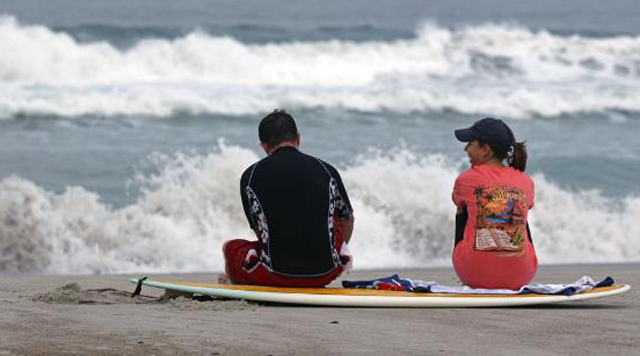(CBS/AP)Updated 3:32 p.m. ET
BUXTON, N.C. - Thousands were fleeing an exposed strip of coastal villages and beaches off North Carolina on Thursday as Irene approached, threatening to become the first major hurricane to hit the East Coast in seven years.
Hours after a hurricane watch was issued for much of the state's coast, emergency officials expanded evacuation orders to include hundreds of thousands of tourists and locals in three counties. The areas include the barrier island chain known as the Outer Banks, which is expected to take the brunt of Irene's first hit over the weekend.
New Jersey was the latest state to declare a state of emergency early Thursday afternoon. Gov. Chris Christie said the current track calls for New Jersey to face a serious, significant event and warned residents to prepare for the worst.
Christie said he will not order mandatory evacuations unless absolutely necessary. However, the governor is asking people not to go to the Jersey shore this weekend and for those with rental properties to leave Thursday or Friday.
Earlier, the governors of North Carolina and Virginia made emergency declarations to free up storm recovery resources, while the Navy began moving dozens of ships out to sea from ports in Irene's path. And emergency officials all the way to New England were urging residents in low-lying areas to gather supplies and learn the way to a safe location.
The storm is expected to come ashore Saturday in North Carolina with winds of around 115 (185 kph). Forecasters predict it will then chug up the East Coast, dumping rain from Virginia to New York City before a much-weakened form trudges through New England.
What we have to prepare people for is that a lot of these hurricanes in the northeast scoot out to sea and just miss the coast. This time our luck may be running out, CBS News hurricane consultant David Bernard said on The Early Show Thursday.
Based on the current storm track projections, Bernard says there are two scenarios shaping up: Bad and worse.
The bad scenario cuts the hurricane across Long Island and into New England as a large and strong Category 2 storm. This scenario brings tremendous storm surge on the back bays of Long Island and from the ocean. Massive power disruption and tremendous wind damage will result.
The worst scenario has the hurricane hug the coast all the way to New York City. This would bring tremendous storm surge and wind damage affecting everything from Maryland, right up to the Hudson Valley and across New England.
Most computer models suggest a worst-case scenario is the likeliest.

As the sun rose over North Carolina's barrier islands, tourists packed suitcases in their cars, while locals stocked up on food, water and gas. Traffic was moving briskly Thursday morning on the two-lane highway that cuts through many of the coastal communities, but many feared that would change.
It's going to be a mess, said 66-year-old Buxton resident Leon Reasor as he stood inside a local bait shop. Anyone who tells you they're not worried is a liar.
An evacuation order for an estimated 150,000 visitors took effect Thursday in Dare County, while its 35,000 permanent residents were told to begin leaving the next day. Tourists and locals in Hyde County were also told to move inland, as were visitors in Currituck County.
Carteret County officials ordered a mandatory evacuation for all visitors and non-residents starting at 1 p.m. Thursday.
Residents of the Bogue Banks a barrier island that includes Atlantic Beach, Emerald Isle and other beach communities are supposed to leave starting Friday at 6 a.m.
It wouldn't behoove anyone to stay in these circumstances, Dare County emergency management spokeswoman Sharon Sullivan said. Businesses are boarding up. Nobody can guarantee their safety.
Craig Fugate, the head of the Federal Emergency Management Agency, said residents should pay attention to local broadcasters to see if an evacuation order is made. Among the most important tasks, he said, was figuring out a safe place to go before hitting the road.


